Target Information
| Target General Information | Top | |||||
|---|---|---|---|---|---|---|
| Target ID |
T33990
(Former ID: TTDC00263)
|
|||||
| Target Name |
Macrophage colony-stimulating factor 1 (CSF1)
|
|||||
| Synonyms |
Processed macrophagecolony-stimulating factor 1; MCSF; M-CSF; Lanimostim; CSF-1
Click to Show/Hide
|
|||||
| Gene Name |
CSF1
|
|||||
| Target Type |
Clinical trial target
|
[1] | ||||
| Disease | [+] 2 Target-related Diseases | + | ||||
| 1 | Inflammatory arthropathy [ICD-11: FA2Z] | |||||
| 2 | Solid tumour/cancer [ICD-11: 2A00-2F9Z] | |||||
| Function |
Promotes the release of proinflammatory chemokines, and thereby plays an important role in innate immunity and in inflammatory processes. Plays an important role in the regulation of osteoclast proliferation and differentiation, the regulation of bone resorption, and is required for normal bone development. Required for normal male and female fertility. Promotes reorganization of the actin cytoskeleton, regulates formation of membrane ruffles, cell adhesion and cell migration. Plays a role in lipoprotein clearance. Cytokine that plays an essential role in the regulation of survival, proliferation and differentiation of hematopoietic precursor cells, especially mononuclear phagocytes, such as macrophages and monocytes.
Click to Show/Hide
|
|||||
| UniProt ID | ||||||
| Sequence |
MTAPGAAGRCPPTTWLGSLLLLVCLLASRSITEEVSEYCSHMIGSGHLQSLQRLIDSQME
TSCQITFEFVDQEQLKDPVCYLKKAFLLVQDIMEDTMRFRDNTPNAIAIVQLQELSLRLK SCFTKDYEEHDKACVRTFYETPLQLLEKVKNVFNETKNLLDKDWNIFSKNCNNSFAECSS QDVVTKPDCNCLYPKAIPSSDPASVSPHQPLAPSMAPVAGLTWEDSEGTEGSSLLPGEQP LHTVDPGSAKQRPPRSTCQSFEPPETPVVKDSTIGGSPQPRPSVGAFNPGMEDILDSAMG TNWVPEEASGEASEIPVPQGTELSPSRPGGGSMQTEPARPSNFLSASSPLPASAKGQQPA DVTGTALPRVGPVRPTGQDWNHTPQKTDHPSALLRDPPEPGSPRISSLRPQGLSNPSTLS AQPQLSRSHSSGSVLPLGELEGRRSTRDRRSPAEPEGGPASEGAARPLPRFNSVPLTDTG HERQSEGSFSPQLQESVFHLLVPSVILVLLAVGGLLFYRWRRRSHQEPQRADSPLEQPEG SPLTQDDRQVELPV Click to Show/Hide
|
|||||
| 3D Structure | Click to Show 3D Structure of This Target | AlphaFold | ||||
| HIT2.0 ID | T22BA6 | |||||
| Drugs and Modes of Action | Top | |||||
|---|---|---|---|---|---|---|
| Clinical Trial Drug(s) | [+] 4 Clinical Trial Drugs | + | ||||
| 1 | RG7155 | Drug Info | Phase 2 | Solid tumour/cancer | [2] | |
| 2 | Emactuzumab | Drug Info | Phase 1 | Solid tumour/cancer | [3] | |
| 3 | MSC110 | Drug Info | Phase 1 | Pigmented villonodular synovitis | [4] | |
| 4 | PLX73086 | Drug Info | Phase 1 | Solid tumour/cancer | [1] | |
| Mode of Action | [+] 2 Modes of Action | + | ||||
| Antagonist | [+] 3 Antagonist drugs | + | ||||
| 1 | RG7155 | Drug Info | [1] | |||
| 2 | Emactuzumab | Drug Info | [3] | |||
| 3 | PLX73086 | Drug Info | [1] | |||
| Inhibitor | [+] 1 Inhibitor drugs | + | ||||
| 1 | MSC110 | Drug Info | [4] | |||
| Cell-based Target Expression Variations | Top | |||||
|---|---|---|---|---|---|---|
| Cell-based Target Expression Variations | ||||||
| Different Human System Profiles of Target | Top |
|---|---|
|
Human Similarity Proteins
of target is determined by comparing the sequence similarity of all human proteins with the target based on BLAST. The similarity proteins for a target are defined as the proteins with E-value < 0.005 and outside the protein families of the target.
A target that has fewer human similarity proteins outside its family is commonly regarded to possess a greater capacity to avoid undesired interactions and thus increase the possibility of finding successful drugs
(Brief Bioinform, 21: 649-662, 2020).
Human Tissue Distribution
of target is determined from a proteomics study that quantified more than 12,000 genes across 32 normal human tissues. Tissue Specificity (TS) score was used to define the enrichment of target across tissues.
The distribution of targets among different tissues or organs need to be taken into consideration when assessing the target druggability, as it is generally accepted that the wider the target distribution, the greater the concern over potential adverse effects
(Nat Rev Drug Discov, 20: 64-81, 2021).
Human Pathway Affiliation
of target is determined by the life-essential pathways provided on KEGG database. The target-affiliated pathways were defined based on the following two criteria (a) the pathways of the studied target should be life-essential for both healthy individuals and patients, and (b) the studied target should occupy an upstream position in the pathways and therefore had the ability to regulate biological function.
Targets involved in a fewer pathways have greater likelihood to be successfully developed, while those associated with more human pathways increase the chance of undesirable interferences with other human processes
(Pharmacol Rev, 58: 259-279, 2006).
Biological Network Descriptors
of target is determined based on a human protein-protein interactions (PPI) network consisting of 9,309 proteins and 52,713 PPIs, which were with a high confidence score of ≥ 0.95 collected from STRING database.
The network properties of targets based on protein-protein interactions (PPIs) have been widely adopted for the assessment of target’s druggability. Proteins with high node degree tend to have a high impact on network function through multiple interactions, while proteins with high betweenness centrality are regarded to be central for communication in interaction networks and regulate the flow of signaling information
(Front Pharmacol, 9, 1245, 2018;
Curr Opin Struct Biol. 44:134-142, 2017).
Human Similarity Proteins
Human Tissue Distribution
Human Pathway Affiliation
Biological Network Descriptors
|
|
|
There is no similarity protein (E value < 0.005) for this target
|
|
Note:
If a protein has TS (tissue specficity) scores at least in one tissue >= 2.5, this protein is called tissue-enriched (including tissue-enriched-but-not-specific and tissue-specific). In the plots, the vertical lines are at thresholds 2.5 and 4.
|
| KEGG Pathway | Pathway ID | Affiliated Target | Pathway Map |
|---|---|---|---|
| MAPK signaling pathway | hsa04010 | Affiliated Target |
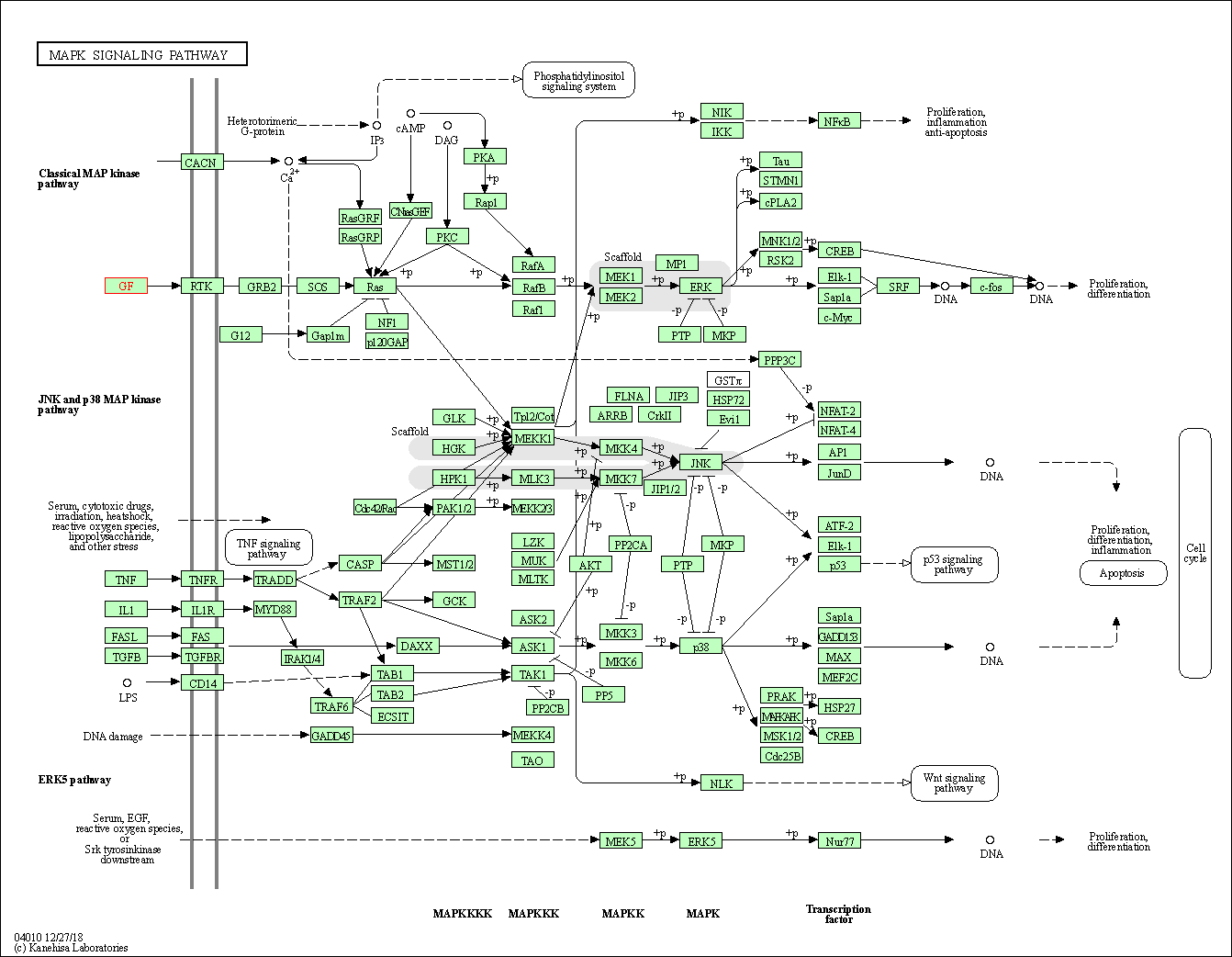
|
| Class: Environmental Information Processing => Signal transduction | Pathway Hierarchy | ||
| Ras signaling pathway | hsa04014 | Affiliated Target |

|
| Class: Environmental Information Processing => Signal transduction | Pathway Hierarchy | ||
| Rap1 signaling pathway | hsa04015 | Affiliated Target |
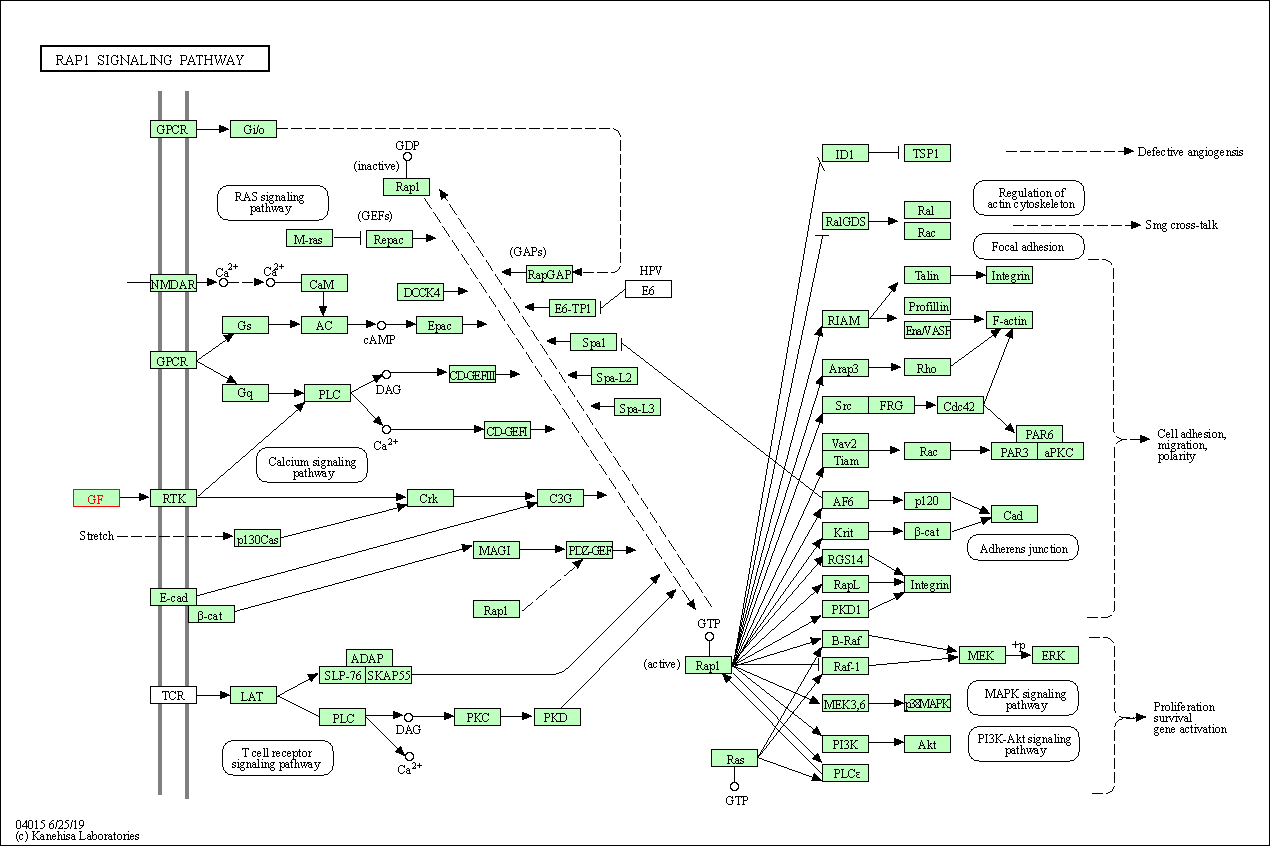
|
| Class: Environmental Information Processing => Signal transduction | Pathway Hierarchy | ||
| Cytokine-cytokine receptor interaction | hsa04060 | Affiliated Target |

|
| Class: Environmental Information Processing => Signaling molecules and interaction | Pathway Hierarchy | ||
| Viral protein interaction with cytokine and cytokine receptor | hsa04061 | Affiliated Target |
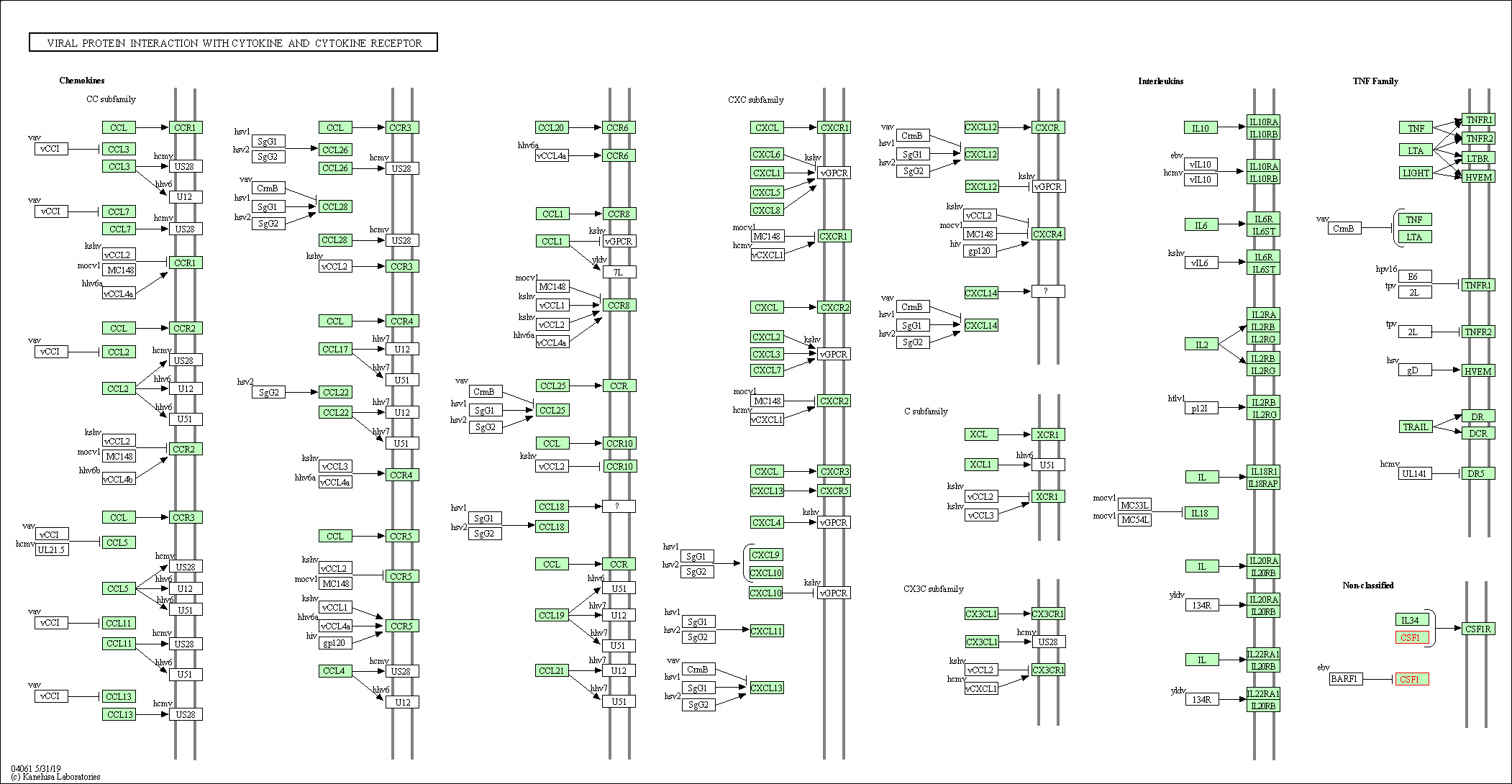
|
| Class: Environmental Information Processing => Signaling molecules and interaction | Pathway Hierarchy | ||
| PI3K-Akt signaling pathway | hsa04151 | Affiliated Target |
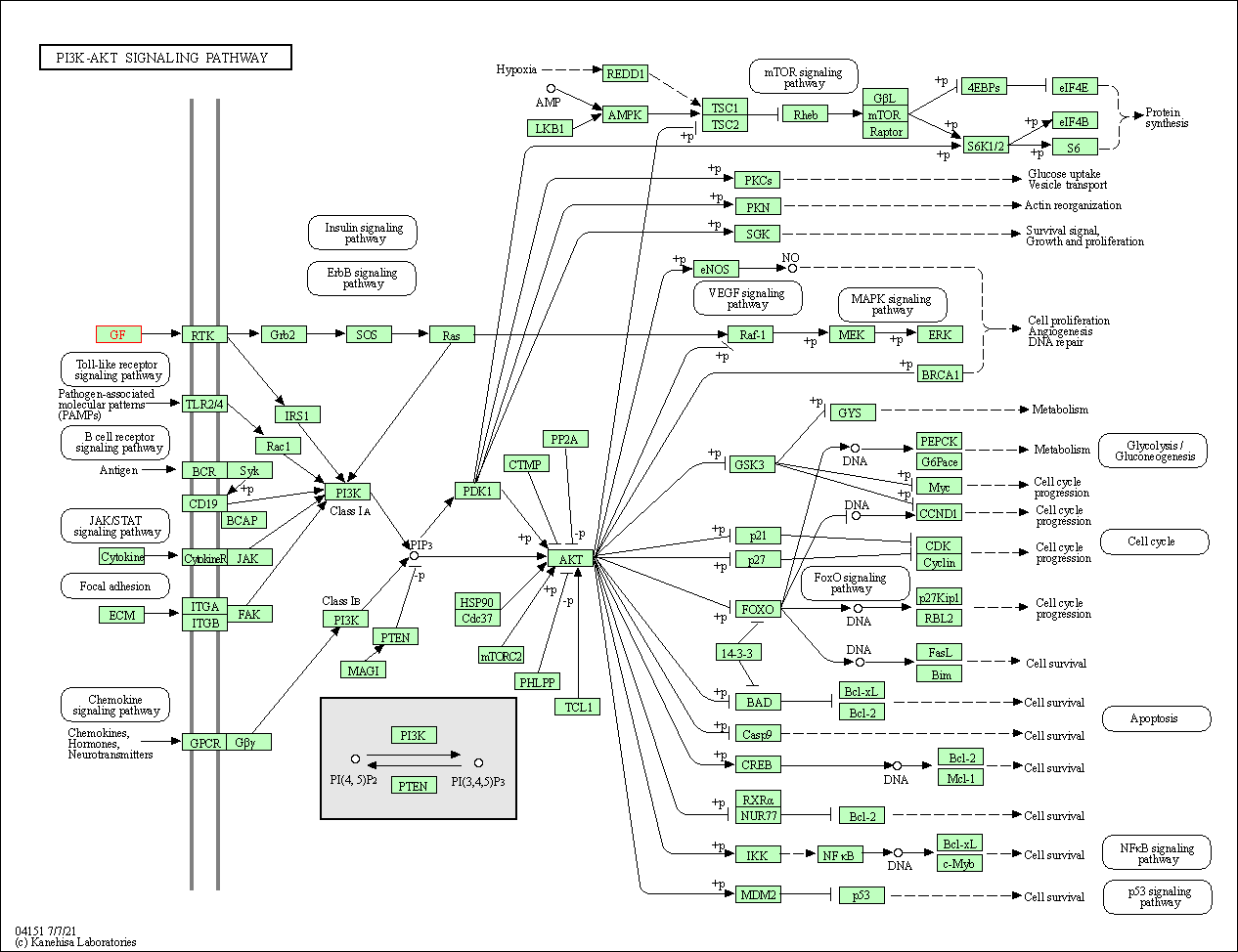
|
| Class: Environmental Information Processing => Signal transduction | Pathway Hierarchy | ||
| Osteoclast differentiation | hsa04380 | Affiliated Target |
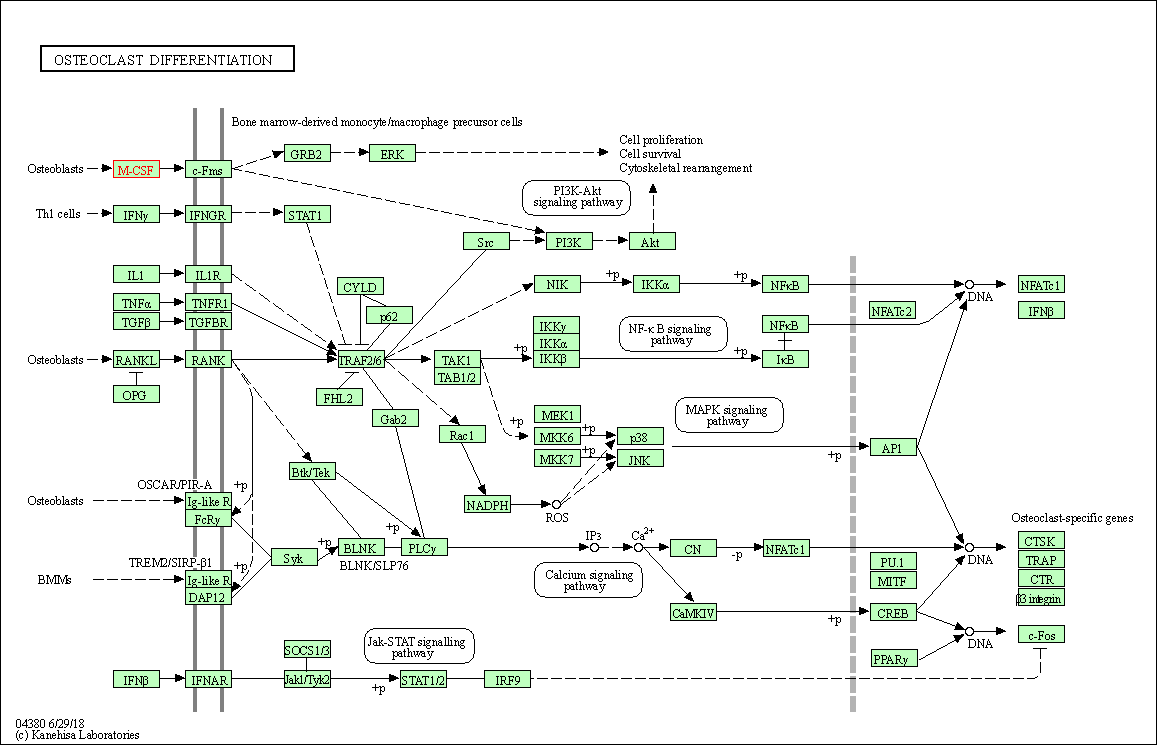
|
| Class: Organismal Systems => Development and regeneration | Pathway Hierarchy | ||
| Hematopoietic cell lineage | hsa04640 | Affiliated Target |
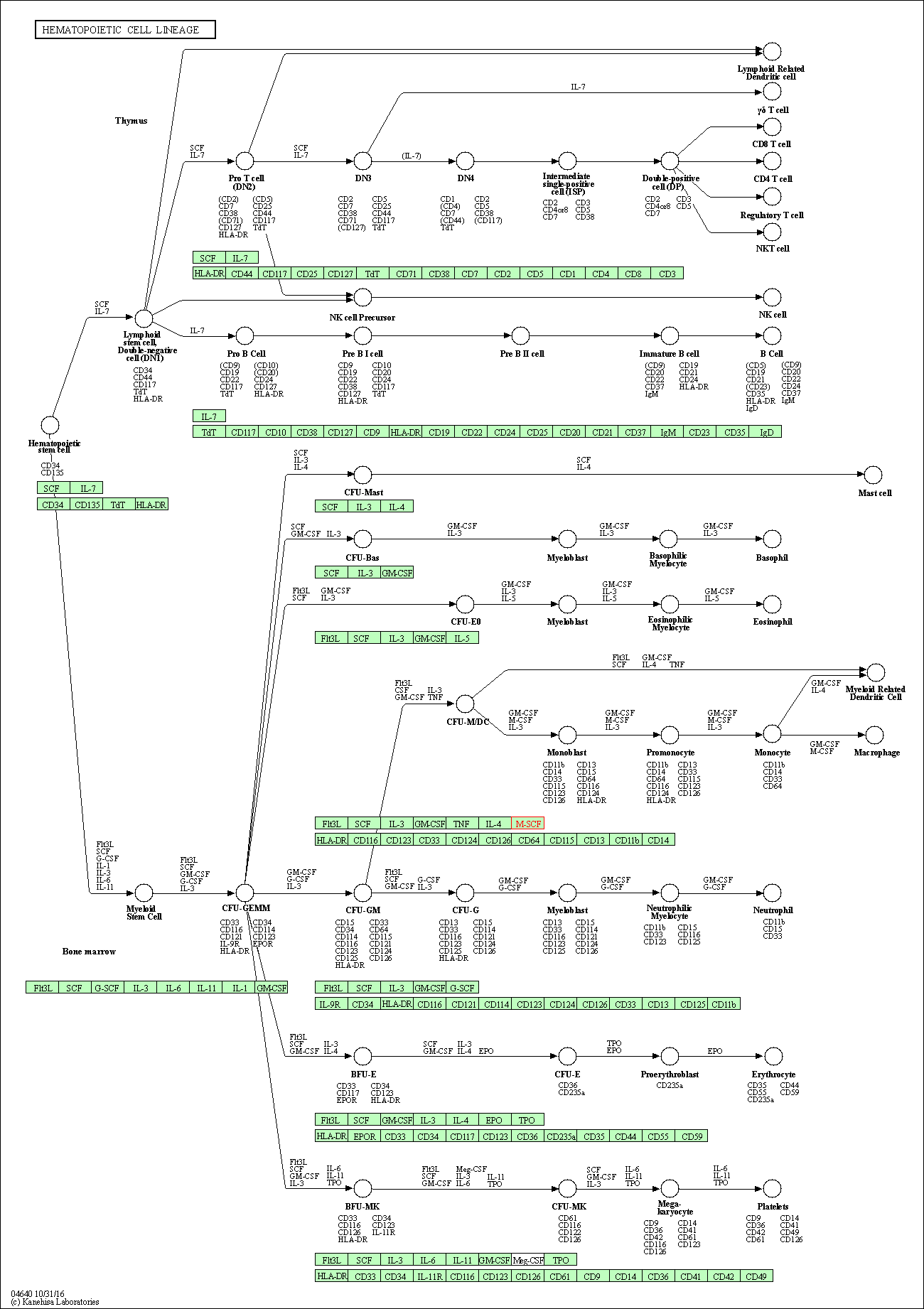
|
| Class: Organismal Systems => Immune system | Pathway Hierarchy | ||
| TNF signaling pathway | hsa04668 | Affiliated Target |
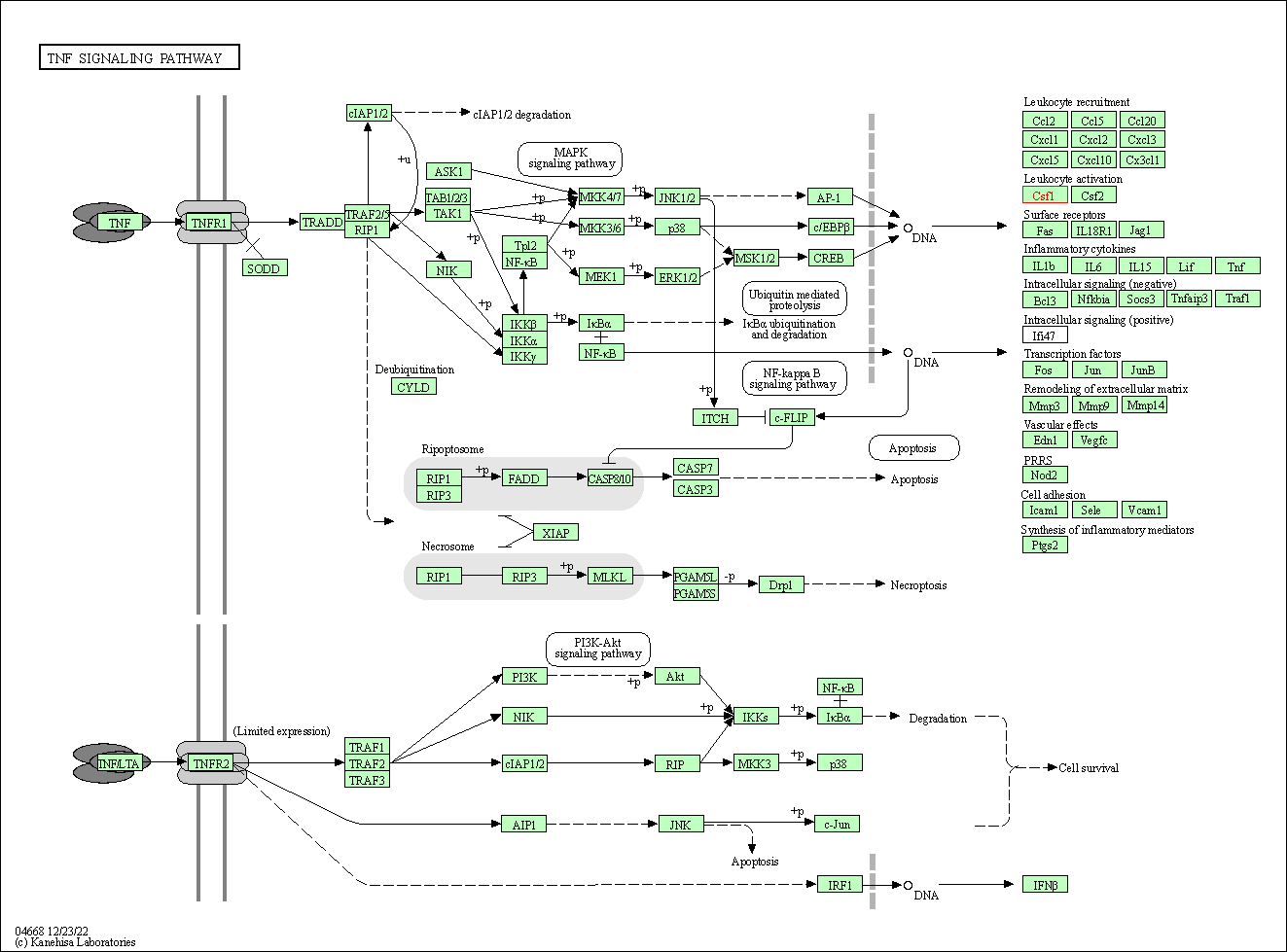
|
| Class: Environmental Information Processing => Signal transduction | Pathway Hierarchy | ||
| Click to Show/Hide the Information of Affiliated Human Pathways | |||
| Degree | 6 | Degree centrality | 6.45E-04 | Betweenness centrality | 2.49E-05 |
|---|---|---|---|---|---|
| Closeness centrality | 1.99E-01 | Radiality | 1.34E+01 | Clustering coefficient | 4.67E-01 |
| Neighborhood connectivity | 2.00E+01 | Topological coefficient | 2.22E-01 | Eccentricity | 12 |
| Download | Click to Download the Full PPI Network of This Target | ||||
| Target Regulators | Top | |||||
|---|---|---|---|---|---|---|
| Target-regulating microRNAs | ||||||
| Target Profiles in Patients | Top | |||||
|---|---|---|---|---|---|---|
| Target Expression Profile (TEP) | ||||||
| Target Affiliated Biological Pathways | Top | |||||
|---|---|---|---|---|---|---|
| KEGG Pathway | [+] 8 KEGG Pathways | + | ||||
| 1 | Ras signaling pathway | |||||
| 2 | Rap1 signaling pathway | |||||
| 3 | Cytokine-cytokine receptor interaction | |||||
| 4 | PI3K-Akt signaling pathway | |||||
| 5 | Osteoclast differentiation | |||||
| 6 | Hematopoietic cell lineage | |||||
| 7 | TNF signaling pathway | |||||
| 8 | Rheumatoid arthritis | |||||
| NetPath Pathway | [+] 4 NetPath Pathways | + | ||||
| 1 | TSH Signaling Pathway | |||||
| 2 | IL2 Signaling Pathway | |||||
| 3 | EGFR1 Signaling Pathway | |||||
| 4 | TGF_beta_Receptor Signaling Pathway | |||||
| PID Pathway | [+] 3 PID Pathways | + | ||||
| 1 | Signaling events mediated by PTP1B | |||||
| 2 | Signaling events mediated by TCPTP | |||||
| 3 | Integrins in angiogenesis | |||||
| WikiPathways | [+] 5 WikiPathways | + | ||||
| 1 | Cytokines and Inflammatory Response | |||||
| 2 | Hematopoietic Stem Cell Differentiation | |||||
| 3 | Differentiation Pathway | |||||
| 4 | miR-targeted genes in muscle cell - TarBase | |||||
| 5 | Folate Metabolism | |||||
| Target-Related Models and Studies | Top | |||||
|---|---|---|---|---|---|---|
| Target Validation | ||||||
| References | Top | |||||
|---|---|---|---|---|---|---|
| REF 1 | Clinical pipeline report, company report or official report of the Pharmaceutical Research and Manufacturers of America (PhRMA) | |||||
| REF 2 | Trusted, scientifically sound profiles of drug programs, clinical trials, safety reports, and company deals, written by scientists. Springer. 2015. Adis Insight (drug id 800035593) | |||||
| REF 3 | Clinical pipeline report, company report or official report of the Pharmaceutical Research and Manufacturers of America (PhRMA) | |||||
| REF 4 | Colony-Stimulating Factor-1 Antibody Lacnotuzumab in a Phase 1 Healthy Volunteer Study and Mechanistic Investigation of Safety Outcomes. J Pharmacol Exp Ther. 2019 Jun;369(3):428-442. | |||||
If You Find Any Error in Data or Bug in Web Service, Please Kindly Report It to Dr. Zhou and Dr. Zhang.

